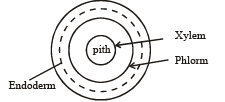31 Years NEET Previous Year Questions: Anatomy of Flowering Plants - 2 - NEET MCQ
25 Questions MCQ Test Biology 31 Years NEET Chapterwise Solved Papers - 31 Years NEET Previous Year Questions: Anatomy of Flowering Plants - 2
For a critical study of secondary growth in plants. Which one of the following pairs is suitable?
[2007]
A common structural feature of vessel elements and sieve tube elements are
[2006]
| 1 Crore+ students have signed up on EduRev. Have you? Download the App |
In a woody dicotyledonous tree, which of the following parts will mainly consist of primary tissues?
[2005]
Ectophloic siphonostele is found in
The most abundant element present in the plants is
[2004]
In a longitudinal section of a root, starting from the tip upward, the four zones occur in the following order:
[2004]
Chlorenchyma is known to develop in the
[2003]
The apical meristem of the root is present
[2003]
The cells of the quiescent centre are characterised by
[2003]
Which of the following statements is true?
[2002]
Axillary bud and terminal bud are derived from the activity of
[2002]
Four radial vascular bundles are found in
[2002]
Vessels are found in
[2002]
Main function of lenticel is
[2002]
Loading of pholem is related to
[2001]
What happens during vascularization in plants?
[2000]
Transition of radial vascular bundle in root to conjoint vascular bundle in stem occurs in which zone?
[1999]
Which of the following meristems is responsible for extrastelar secondary growth in dicotyledonous stem?
[1998]
A leaf primordium grows into the adult leaf lamina by means of
[1998]
At maturity which of the following is enucleate?
[1997]
What is not true about sclereids?
[1996]
As the secondary growth takes place (proceeds) in a tree, thickness of
[1994]
Procambium forms
[1994]
A narrow layer of thin walled cells found between phloem/bark and wood of a dicot is
[1993]
Periderm is produced by
[1993]
|
33 docs|83 tests
|
|
33 docs|83 tests
|


















